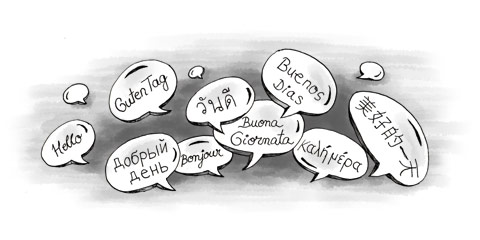Further languages spoken in the Czech Republic are Slovak, German, Polish and Romani. Since Czech shares the same roots as Slovak, speakers of each language are able to communicate without too much problem, although there are dialects that are hard to understand for speakers of the other language. However, mutual intelligibility is given to Slovak and, to a lesser extent, also to Polish and Sorbian.
Czech is also spoken in parts of Germany, Austria, Poland, Slovakia and the Ukraine. This is limited to the border regions. In addition there are large Czech communities in the USA, particularly New York, Chicago, and in Australia.
The Czech language
Czech is a fusional language, which means that the endings of words define several characteristics of the word, such as tense, mood, etc. In addition there are seven cases and three genders making Czech even more complicated to learn for beginners.
The stress in Czech is always on the first syllable. In most cases the intonation of a sentence is declining with the exception of yes-no questions. In this case the intonation rises at the end of the sentence.
Czech is pronounced according to its writing. Each letter resembles a single sound. Once you know how to pronounce each letter you can easily read and pronounce Czech.
In general, Czech uses the Latin alphabet. However there are some additional letters. Most of the time this concerns vowels. As there are short and long vowels, accents are needed to differentiate between them. Aside from that there are sounds in Czech that cannot be represented by Latin letters. Therefore the hacek symbol is added to the letter. Examples for accented vowels and letters with the hacek symbol are á, é, í and š, ž, č, ř, ň.
Czech Dialects
There are two major dialects of Czech in the Czech Republic. Neither differ from standard written Czech very much. Therefore, anybody able to speak Czech will have relatively little problem understanding the dialects.
The first major dialect is „common“ Czech. It is spoken in Bohemia, the western part of the Czech Republic. It is marked by few grammatical changes compared to standard Czech including different noun declensions. These however can be very confusing as they can cause a change of tense and therefore meaning of a sentence. Common Czech also has slight variations in pronunciation.
The second major dialect is spoken in Moravia and Silesia, the eastern part of the Czech Republic. It is very close to common Czech and only differs in the use of some words. Usually these vocabulary changes are due to foreign language influences, such as German or Polish.

